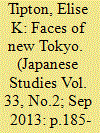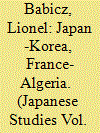|
|
|
Sort Order |
|
|
|
Items / Page
|
|
|
|
|
|
|
| Srl | Item |
| 1 |
ID:
123490


|
|
|
|
|
| Publication |
2013.
|
| Summary/Abstract |
Between 1932 and 1945 the Japanese military raised a number of 'puppet' armies. While research has focused on the motives of those who opted to collaborate with the Japanese during the period, little work has been done regarding the composition of these forces. The article examines the Kwantung Army's January 1936 plans for an Inner Mongolian Army, and the reasons why this 'army' never eventuated in the form that had been planned. This sheds light on how officers of the Kwantung Army understood, and misunderstood, the potential of peoples of North China to become useful collaborators in wresting the region from the Nationalist Chinese control.
|
|
|
|
|
|
|
|
|
|
|
|
|
|
|
|
| 2 |
ID:
123491


|
|
|
|
|
| Publication |
2013.
|
| Summary/Abstract |
This study focuses on a comparison of the three most popular sakariba (entertainment districts) in Tokyo of the late 1920s and 1930s to highlight the new role of leisure in everyday life as Japan industrialized and urbanized. The comparison of Asakusa, Ginza and Shinjuku shows that even as Japan became a mass society, leisure practices and patterns became stratified and diversified. This stratification and diversification reflected class, age and cultural tastes. The three sakariba developed distinctive characters and attractions for consumers, raising challenges to mass culture critics' assumption that the rise of mass culture and commodity culture would lead to homogenization of taste and recreational products and a lack of consumer choice.
|
|
|
|
|
|
|
|
|
|
|
|
|
|
|
|
| 3 |
ID:
123488


|
|
|
|
|
| Publication |
2013.
|
| Summary/Abstract |
This paper examines the way the outcaste head Danzaemon, or more precisely several individuals who successively bore that title, negotiated their place in the eighteenth-century Edo status order through official genealogical pronouncements. Eta and hinin groups became closely linked together in the political imaginary in Edo from around the beginning of the eighteenth century in an extraordinary legal battle that emerged between the leaders of these groups. The head of the former group, Danzaemon Chikamura, achieved a qualified victory in this struggle through genealogical posturing, positioning himself at the apex of an increasingly well-defined Edo outcaste order. By the second half of the eighteenth century, the privileged place within the order held by the next Danzaemon came under renewed pressure from a new generation of hinin. As a result, Danzaemon Chikasono made an attempt to rearticulate the grounds for his status through a different kind of genealogical statement. This article, using the official correspondence between Danzaemon and the Edo City Magistrate, examines the distinctive features of the genealogical imaginations of these two outcaste leaders in order to reveal the ways they negotiated their place within the Edo outcaste order.
|
|
|
|
|
|
|
|
|
|
|
|
|
|
|
|
| 4 |
ID:
123492


|
|
|
|
|
| Publication |
2013.
|
| Summary/Abstract |
This article compares the colonial situations, decolonisation processes and post-colonial relations of two former colonial 'couples', Japan-Korea and France-Algeria. Japan's modern history until 1945 was not only a history of war, but also of colonialism. The Japanese modern takeover of Korea was a colonial enterprise, and Japanese colonialism in Korea was motivated by ideas partly similar to the policy implemented by the French in Algeria. Both Korea and Algeria were an integral part of the coloniser's national territory, and the fate of the two provinces was to be total assimilation. The processes of reconciliation that have taken place since liberation are also best understood within a decolonisation paradigm. While the respective relationships are dictated by specific geopolitical factors and policy choices, the colonial past is casting a similar shadow on both the former colonisers and their former victims.
|
|
|
|
|
|
|
|
|
|
|
|
|
|
|
|
| 5 |
ID:
123489


|
|
|
|
|
| Publication |
2013.
|
| Summary/Abstract |
From the beginning of the eighteenth century, rural enthusiasts in the arts took part in production of printed materials, often with help from urban professionals and the publishing industry. Their works in print constitute concrete evidence of the diffusion of the arts from urban centres to the provinces during the Tokugawa period. Taking Echigo province as a case study, this essay explores provincial amateurs' publishing projects, particularly in haikai and Chinese poetry. Materials in this province show a steady development of cultural mechanisms that promoted provincial people's participation in book publishing and printmaking as an objective of their literary activities. This study provides evidence of interplay between the growing print culture and people's desire to publish their works in the context of the development of mass culture in Tokugawa society.
|
|
|
|
|
|
|
|
|
|
|
|
|
|
|
|
| 6 |
ID:
123487


|
|
|
|
|
| Publication |
2013.
|
| Summary/Abstract |
The life of Philipp Franz von Siebold's daughter Ine, who became the first woman trained in Western medicine in Japan, came to wide popular attention in the 1970s with Yoshimura Akira's famous historical novel on the circumstances of her birth, training and subsequent career. As the child of mixed parentage, born near or perhaps even on Dejima, Ine's life symbolized the turmoil faced by Japan in its confrontation with the West in the nineteenth century. The extent to which an accurate biography of Ine can be established is, however, difficult, and the historian's quest to verify the basis of such a famous fictional account seemingly doomed to fail. This article details aspects of this quest; in so doing it raises questions around the nature of archival research, of biographical writing, and the ability of historians to understand and portray accurately the lives of those who lived in and around the foreign settlement at Dejima.
|
|
|
|
|
|
|
|
|
|
|
|
|
|
|
|
|
|
|
|
|